ProjectsPast and current JFS projects
[Get Inspired by Nature] Inspired by Form and Structure
This page is devoted to both Japanese and overseas examples of technology derived from study of the form and structure of animals and plants.
(See "Table legend" at the bottom of this page for an explanation of table content)
 Photo by brittanyhock | Elephant |
| Communicates with other elephants far away | |
| Use of infrasound | |
| Elephants use the soles of their feet to pick up sounds generated 30-40 km away that are of a far lower frequency than humans can hear. | |
| Forecasting tsunami and unusual movements in the earth's crust | |
| Dr. Joyce Poole | |
| AskNature: Vibrations alert others to danger -- elephants Amazing Nature Database: Elephant tsunami prediction (Japanese only) | |
 Photo by wwarby | Black kite eye |
| Controls the amount of UV light entering the eye | |
| Protection of eye by reducing glare | |
| Blood vessels arranged in a pleated pattern form a membrane (pectin oculi) in the eye that produces melanin on exposure to UV light to block it from damaging the back of the eye. | |
| More effective sunglasses, window glass | |
| Professor S.G. Kiama et al., University of Nairobi | |
| Amazing Nature Database: How black kites protect their eyes from UV light (Japanese only) | |
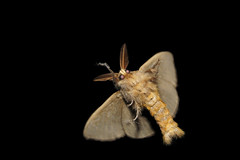 Photo by pjoh | Moth eye |
| Traps incident light and prevents reflection | |
| Microscopic nipple structure | |
| The surface of moth eyes is covered in microscopic nipples that refract light repeatedly, preventing it from being reflected. | |
| Non-reflective screens, anti-reflective film for coating photovoltaic cells | |
| Mitsubishi Rayon Co., Oji Paper Co. and many others | |
| AskNature: Moth eye antireflective coatings Amazing Nature Database: The light-trapping moth eye (Japanese only) | |
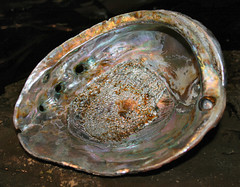 Photo by rachaelwrites | Abalone |
| Has a very strong shell | |
| Tough ceramic materials | |
| Abalone shells have a laminate structure composed of over 1,000 extremely thin layers of calcium carbonate. | |
| Lightweight car or rocket body material | |
| National Institute for Materials Science, etc. | |
| AskNature: Shells are tough: red abalone Amazing Nature Database: Why an abalone shell can survive being hit with a hammer or run over by a car (Japanese only) | |
 Photo by counti8 | Lotus leaf |
| Repels water | |
| Antifouling, water-repellent coating | |
| Minute nooks, crannies and knobs on the surface of lotus leaves cause water to form into droplets that also gather dirt as they roll off the leaf. | |
| Outer walls, toilets, textiles, car wing mirrors etc. that are resistant to fouling | |
| University of Bonn, etc. | |
| AskNature: Hydrophobic surface allows self-cleaning -- sacred lotus Amazing Nature Database: Lotus leaves that repel water and never get dirty by creating water droplets (Japanese only) | |
 Photo by alles-schlumpf | Gecko |
| Climbs vertical walls and walks across ceilings without losing grip | |
| Adhesive tape | |
| The hair-like setae on the footpads of geckos enhance the strength of physical forces of attraction known as van der Waals forces, enabling geckos to adhere to surfaces. | |
| Strongly adhesive tape that is also easy to peel off | |
| University of Manchester/ Dayton University/ Nitto Denko/ Osaka University, etc. | |
| AskNature: Gecko Inspired Bandage Amazing Nature Database: How geckos runs across ceilings (Japanese only) | |
 Photo by Mike_tn | Burdock seed |
| Clings to a substrate | |
| Fastener | |
| The tips of the seeds are hooked, and easily attach to fabric and other materials. | |
| VelcroR | |
| Velcro / Kuraray, etc. | |
| AskNature: Hooks adhere to wooly coats -- burdock Amazing Nature Database: Burdock, the seed that sticks to you and never lets go (Japanese only) | |
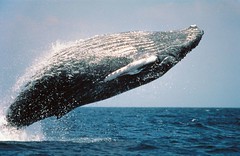 Photo by flickkerphotos | Humpback whale flippers |
| Bumpy-ridged | |
| Wind turbine blades | |
| The bumps (tubercles) on the flippers enable the whale to better control the flow of water across the flipper and prevent stalling even at slow speeds. | |
| Wind turbine that turns in light winds and creates little noise and vibration | |
| WhalePower Corporation | |
| AskNature: Flippers provide lift, reduce drag -- humpback whale Amazing Nature Database: The energy-efficient design of humpback whale flippers (Japanese only) | |
 Photo by Ros in wonderland | Shark scales |
| Smooth from head to tail, rough from tail to head | |
| Reduction of friction with water | |
| Minute grooves on surface of the scales reduce friction and prevent turbulence. | |
| Competition swimwear, boat surface coatings | |
| Mizuno Corp. / SpeedoR(Goldwin/ Speedo International Ltd.), etc. | |
| AskNature: Skin reduces drag -- shark Amazing Nature Database: Sharkskin for smooth and speedy swimming (Japanese only) | |
 Photo by The_Gut | Cuttlefish |
| Changes body color | |
| Display screens | |
| Cuttlefish change color by changing arrangement of muscle pigment cells in response to signals sent from eyes to brain. | |
| Energy-efficient displays that are easy on the eyes | |
| TDK, etc. | |
| AskNature: Rapid color change used for protection -- cuttlefish Amazing Nature Database: Changing color in a flash like the cuttlefish (Japanese only) | |
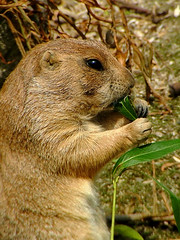 Photo by jpockele | Rodent (rats, squirrels, beaver, etc.) teeth |
| Razor-sharp incisors | |
| Blades that remain sharp | |
| Rodent incisors retain their sharpness through continuous growth and wear. | |
| New dental treatments, industrial machine blades | |
| AskNature: Teeth are resilient -- sea otter Amazing Nature Database: Rodent teeth that sharpen themselves through constant nibbling (Japanese only) | |
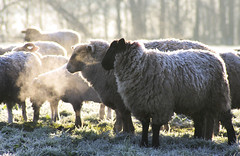 Photo by Peewubblewoo | Sheep wool |
| Keeps sheep warm in winter and cool in summer | |
| Acryl, felt | |
| The protein that makes up wool forms helical coils that give wool its ability to hold air. | |
| Fibers that conduct little heat and are resistant to friction and stretching | |
| Nagao Shoji, etc. | |
| Amazing Nature Database: Wearing air to stay cool in summer and warm in winter (Japanese only) | |
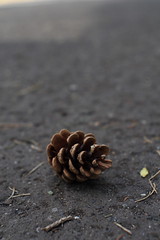 Photo by underclasscameraman | Pine cone |
| Ejects seeds when humidity is low | |
| Smart fabrics that become more or less porous according to humidity | |
| Because seeds will not fly far if the air is humid, pine cones open up when humidity is low so that seeds are released at the best time. | |
| Development of new fibers that respond to humidity, windows that open and close without a power source, etc. | |
| Professor Julian Vincent, University of Bath / MMT Textiles, etc. | |
| AskNature: Cone scales are humidity-sensitive -- pine Amazing Nature Database: The humidity-sensitive pine cone (Japanese only) | |
 Photo by Josoroma | Morpho butterfly wings |
| Coated in microscopic scales | |
| Reflective coatings, structural colored fibers, displays that require no backlighting | |
| The scales have a complex layered structure that gives them a blue shimmer depending on angle without having any actual blue pigment. | |
| Coloring without pigments, saving energy with displays that do not require backlighting | |
| Teijin, JDS Uniphase, Qualcomm, etc. | |
| AskNature: Morphotex structural colored fibers Fast Company website Biomimicry: Nature-Inspired Designs NHK Eco Channel: Science writer Janine Benyus (2) Mimicking natural structures (Japanese only) | |
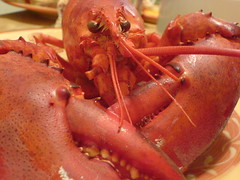 Photo by man pikin | Lobster |
| Covered in a hard shell (carapace) | |
| Mobile phone housing | |
| 2-layered structure of hard and soft layers of chitin combined with calcium carbonate | |
| Tough material able to withstand shock, vibration and changes in temperature | |
| Motorola | |
| Fast Company website Biomimicry: Nature-Inspired Designs | |
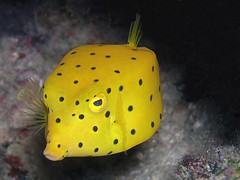 Photo by gwylow71 | Box fish |
| Box-shaped | |
| Tougher, lighter car body | |
| The box fish's bony plate has evolved to give the body a sturdy box shape that also glides easily through water. | |
| Car that is not only tough and light, but also aerodynamic, reducing fuel consumption | |
| Mercedes Benz | |
| AskNature: Fish maintain stability in turbulence -- spotted boxfish Amazing Nature Database: It may not look it, but the box fish is streamlined as well as sturdy (Japanese only) | |
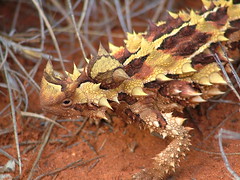 Photo by Nokes | Thorny Devil |
| Uses spiny ridges to channel scarce water to its mouth | |
| Water collection device | |
| The grooves between the spiny ridges channel water to the lizard's mouth by capillary effect. | |
| Gathering atmospheric moisture to produce drinking water, carrying water to the top floor of high buildings without expending any power | |
| AskNature: Grooves gather water -- thorny devil Amazing Nature Database: A lizard equipped with its own water supply (Japanese only) | |
 Photo by Mshai | Wasp nestHexagonal structure |
| Substructure supporting the surface of huge observatory telescope mirrors | |
| Lightweight but sturdy enough to support weight, and also permeable (with cavities) | |
| Supports the heavy 8.5 m-wide mirror surface so well that it bends no more than 15 nm. The cavity structure also enables air to circulate, cooling the glass and creating a sharper image. | |
| Steward Observatory Mirror Lab, University of Arizona | |
| Fast Company website Biomimicry: Nature-Inspired Designs | |
| University of Arizona press release | |
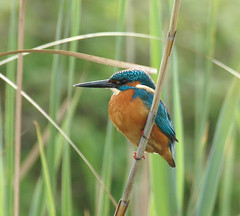 Photo by Sergey Yeliseev | Kingfisher |
| Dives | |
| Bullet train 500 series nose design | |
| The kingfisher dives at high speed with very little splash, thanks to its slightly parabolic beak shape | |
| Little wind resistance even at high speed, noise reduction | |
| Eiji Nakatsu, Test Director (former), West Japan Railway Co. | |
| JFS Biomimicry Interview Series: No.6 "Shinkansen Technology Learned from an Owl?" - The story of Eiji Nakatsu | |
 Photo by weboo | Termite mound |
| Maintains stable internal temperature through adjusting humidity and circulating air | |
| INAX Ecocarat breathing walls | |
| Building materials made of clay can leverage clay's porous nature to enable ventilation and humidity adjustment. | |
| Walls or floors that automatically adjust humidity control and remove odors | |
| INAX Corp. | |
| AskNature: Mound passively heats/cools -- compass termite Nature Technology Database: The outstanding air-conditioning capabilities of termite mounds (Japanese only) | |
 Photo by makitani | Owl feathers |
| Serrated wing feathers | |
| Bullet train 500 series pantographs | |
| The comb-like serrated edges of the feathers reduce noise created during flying. | |
| Giving the pantograph props a serrated profile reduced noise. | |
| Eiji Nakatsu, Test Director (former), West Japan Railway Co. | |
| JFS Biomimicry Interview Series: No.6 "Shinkansen Technology Learned from an Owl?" - The story of Eiji Nakatsus | |
Table legend
| photo credit | Like ... (plant or animal) |
| What it is or does | |
| Outcome | |
| Natural process involved | |
| Potential application for human society | |
| Researcher or research organization | |
| Information source | |
This project has been funded by Hitachi Environment Foundation under its fiscal 2011 funding program for NPOs.


